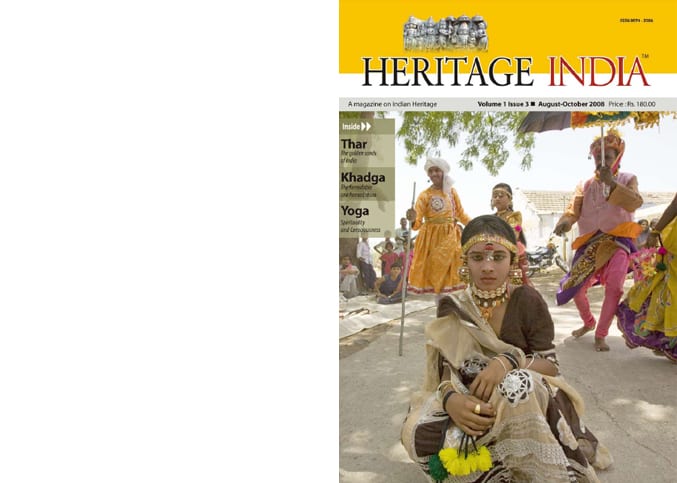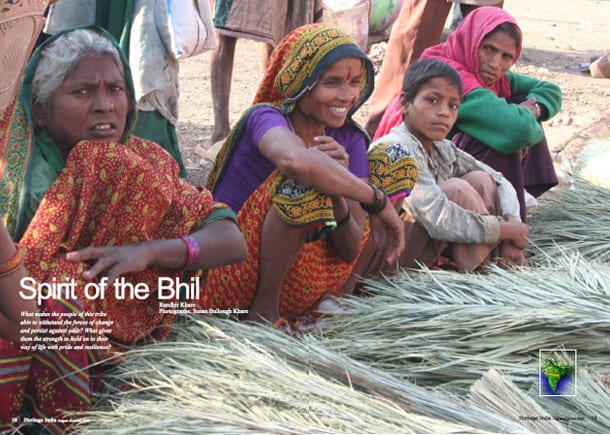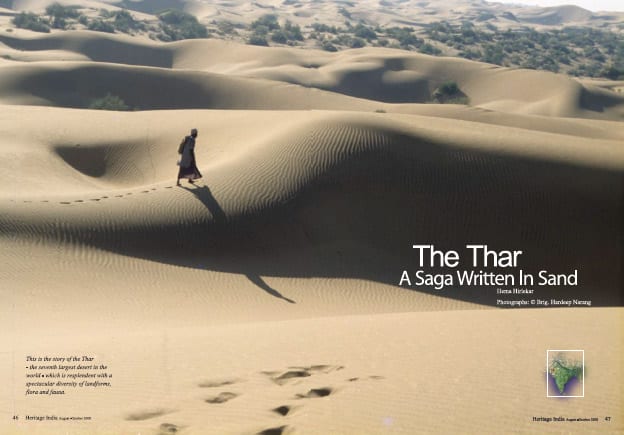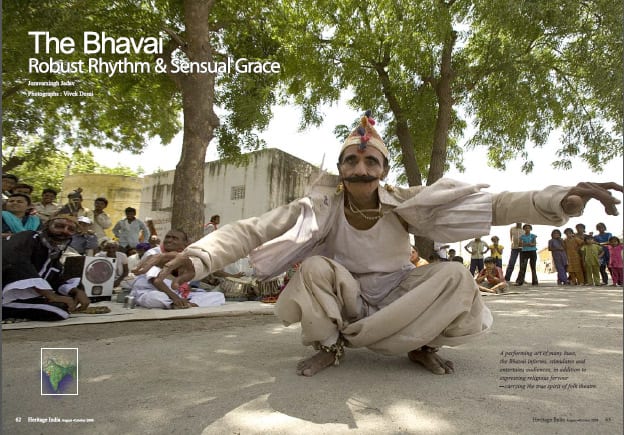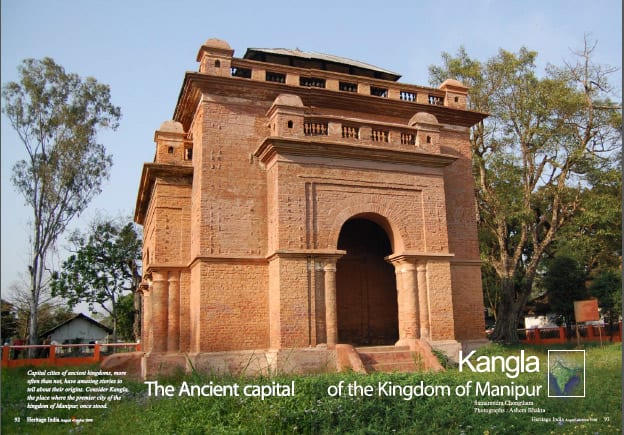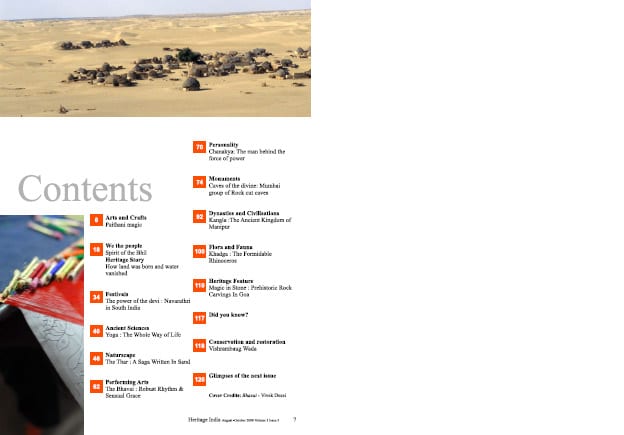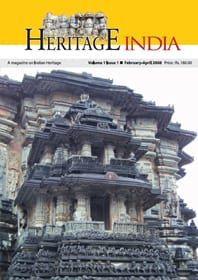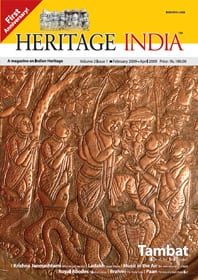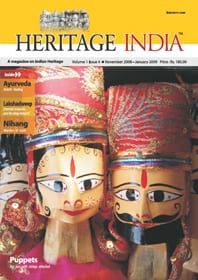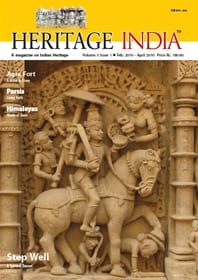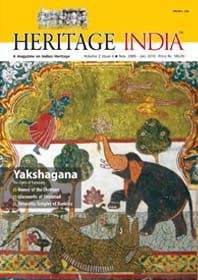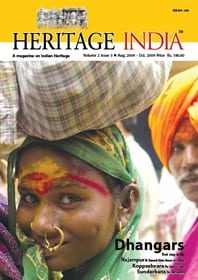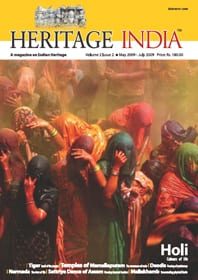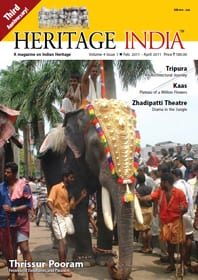Description
In our third issue of Heritage India, we introduce our readers to the little known prehistoric rock carvings in Goa, and explore the rock cut caves of Mumbai. We take a deeper look at the ancient practice of Yoga, and the nearly forgotten Bhavai – a sensual form of dance. The rich wildlife of India is highlighted with the formidable Indian rhinoceros, also known as the ‘khadga’, and we feature the starkly beautiful landscape of the Thar desert. Celebrate the power of the goddess with an article on Navaratri, with your quarterly keepsake – Heritage India!
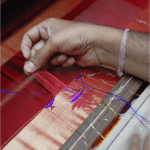 The story of the classic Paithani saree goes back two thousand years and despite the pressures of change, still survives. Mruga Kirloskar follows the threads that weave the tradition of the Paithani into the modern age, with photos by Sandesh Bhandare.
The story of the classic Paithani saree goes back two thousand years and despite the pressures of change, still survives. Mruga Kirloskar follows the threads that weave the tradition of the Paithani into the modern age, with photos by Sandesh Bhandare.
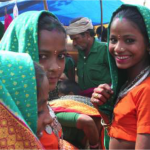 One of the largest tribal groups in the country, the Bhil have survived a hostile world of change and still persist in inhospitable conditions scattered across a belt running through Rajasthan, Gujarat, Madhya Pradesh and Maharashtra. Randhir Khare tries to find out what gives the Bhils their resilience and joy for life under difficult circumstances, with photos by Susan Bullough Khare
One of the largest tribal groups in the country, the Bhil have survived a hostile world of change and still persist in inhospitable conditions scattered across a belt running through Rajasthan, Gujarat, Madhya Pradesh and Maharashtra. Randhir Khare tries to find out what gives the Bhils their resilience and joy for life under difficult circumstances, with photos by Susan Bullough Khare
 Celebrating the triumph of good over evil, the spirit of Navratri connects people, region and cultures. Padma Raghavan and Savita Narayan explain the mythology associated with the festival, with photos by D. Venkatesh, Chellam Krishnan and Radhika Nargolkar.
Celebrating the triumph of good over evil, the spirit of Navratri connects people, region and cultures. Padma Raghavan and Savita Narayan explain the mythology associated with the festival, with photos by D. Venkatesh, Chellam Krishnan and Radhika Nargolkar.
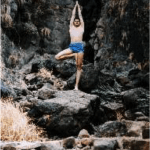 Although the discipline of yoga has shifted from being a spiritual quest to a marketable fitness activity, the essence and tradition of yoga can still be found by those who seek it. Rajvi Mehta traces its evolution to its modern form, with photos by Chandru Melwani, Rajvi Mehta, Ayesha Devi, Lois Steinberg and the RIMYI archives.
Although the discipline of yoga has shifted from being a spiritual quest to a marketable fitness activity, the essence and tradition of yoga can still be found by those who seek it. Rajvi Mehta traces its evolution to its modern form, with photos by Chandru Melwani, Rajvi Mehta, Ayesha Devi, Lois Steinberg and the RIMYI archives.
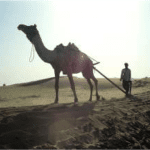 The Thar is the world’s seventh largest desert. Despite its seemingly inhospitable conditions, life persists hidden amidst its shifting sands, as Hema Hirlekar discovers, with photos by Brig. Hardeep Narang.
The Thar is the world’s seventh largest desert. Despite its seemingly inhospitable conditions, life persists hidden amidst its shifting sands, as Hema Hirlekar discovers, with photos by Brig. Hardeep Narang.
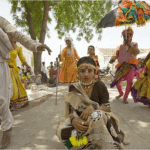 Combining dance, drama, singing and folk narratives, the Bhavai from Gujarat is an all-encompassing art form. Joravarsingh Jadav documents the lives and traditions of these performers, who like many other folk artists are struggling to survive in modern India, with photos by Vivek Desai.
Combining dance, drama, singing and folk narratives, the Bhavai from Gujarat is an all-encompassing art form. Joravarsingh Jadav documents the lives and traditions of these performers, who like many other folk artists are struggling to survive in modern India, with photos by Vivek Desai.
 While Chanakya’s name and philosophy is fast becoming a buzzword among Indian business leaders, little is actually known in historically verifiable terms about his life. V.K. Kshire sheds light on the life of this enigmatic advisor, who contributed to the growth of a strong centralised empire under Chandragupta Maurya.
While Chanakya’s name and philosophy is fast becoming a buzzword among Indian business leaders, little is actually known in historically verifiable terms about his life. V.K. Kshire sheds light on the life of this enigmatic advisor, who contributed to the growth of a strong centralised empire under Chandragupta Maurya.
 Visitors to Mumbai are often swept up by the whirlwind pace of this bustling megapolis. However, amid this chaos lie caves over two millennia old ranging from Kanheri, to Jogeshwari and Elephanta. Noted Indologist Shobhana Gokhale explains the significance of the Mumbai group of rock cut caves, featuring photographs by Suresh Vasant and Shreekant Jadhav.
Visitors to Mumbai are often swept up by the whirlwind pace of this bustling megapolis. However, amid this chaos lie caves over two millennia old ranging from Kanheri, to Jogeshwari and Elephanta. Noted Indologist Shobhana Gokhale explains the significance of the Mumbai group of rock cut caves, featuring photographs by Suresh Vasant and Shreekant Jadhav.
 Once a great city, today only a few ruins remain of Kangla, the once-majestic capital of the kingdom in Manipur. Samarendra Chongtham narrates the rise and decline of the Kangla glory, with photographs by Ashem Bhakra.
Once a great city, today only a few ruins remain of Kangla, the once-majestic capital of the kingdom in Manipur. Samarendra Chongtham narrates the rise and decline of the Kangla glory, with photographs by Ashem Bhakra.
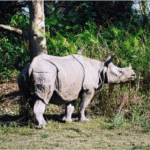 The second largest land mammal in India, and the fourth largest in the world, the one-horned rhinoceros or Khadga is a truly formidable sight to behold. Traces of human fascination with the rhino can be seen in prehistoric cave paintings in Bhimbetka and ancient seals found in Mohenjodaro, and still persist in our modern era. Vijay Sathe captures the lure of the rhino in text and photographs.
The second largest land mammal in India, and the fourth largest in the world, the one-horned rhinoceros or Khadga is a truly formidable sight to behold. Traces of human fascination with the rhino can be seen in prehistoric cave paintings in Bhimbetka and ancient seals found in Mohenjodaro, and still persist in our modern era. Vijay Sathe captures the lure of the rhino in text and photographs.
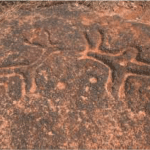 Remnants from a civilization that once was dating from the paleolithic or mesolithic age, the mystical rock carvings in Goa first made their appearance about fifty thousand years ago. Randhir Khare seeks to understand what these carvings meant to the communities that made them, with photos by Susan Bullough-Khare.
Remnants from a civilization that once was dating from the paleolithic or mesolithic age, the mystical rock carvings in Goa first made their appearance about fifty thousand years ago. Randhir Khare seeks to understand what these carvings meant to the communities that made them, with photos by Susan Bullough-Khare.
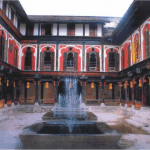 A truly regal house in the heart of Pune, the Vishrambaug Wada has withstood fire, war and the more mundane tests of time such as being used as a municipal office. Over the past few years, a vigorous effort to restore it to its original grandeur has been under way, as Shyam Dhavale of the Pune Municipal Corporation explains.
A truly regal house in the heart of Pune, the Vishrambaug Wada has withstood fire, war and the more mundane tests of time such as being used as a municipal office. Over the past few years, a vigorous effort to restore it to its original grandeur has been under way, as Shyam Dhavale of the Pune Municipal Corporation explains.


